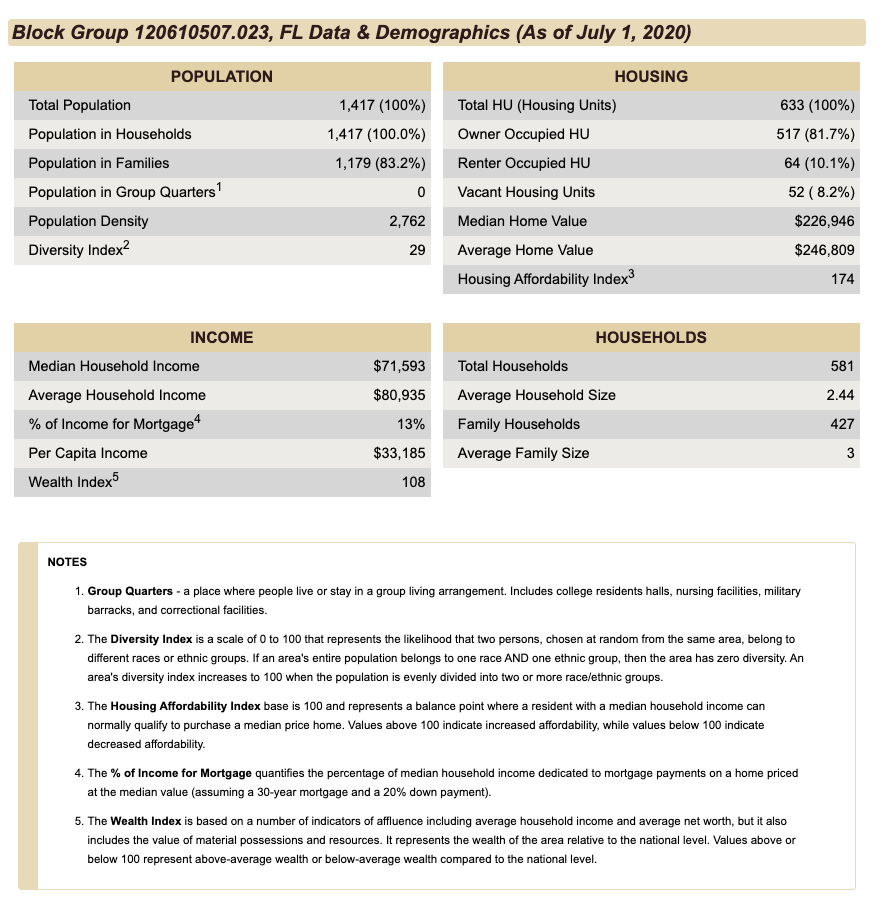Local Research – Find Facts About Anywhere
Review These 6 Questions - Be More Skilled at Local Research
Place/Community Profiles for EIGHT LEVELS of geography:
- Neighborhoods – Census Block Groups that average about 1,500 people
- Cities, Towns, Villages, and Census Designated Places (CDPs are similar to towns but without governmental or administrative functions)
- ZIP Codes – A ZIP Code map defines a populated place that can be characterized with demographic data just like a town or a CDP.
- Counties and County Equalivents such as Parishes in LA, Boroughs/Census Areas in AK, and independent cities in VA.
- County Subdivisions – these can vary widely from state to state.
- MCDs, minor civil divisions, are legally defined governmental units such as townships, towns, or election precincts which may or may not have administrative functions. Currently, 28 states use MCDs as county subdivisions.
- CCDs, census county divisions, are delineated for statistical purposes. Unlike MCDs, CCDs have no legal functions and are not governmental units. Currently, 22 states have CCDs.
- Metropolitan and Micropolitan Statistical Areas (MSAs) – are geographical regions with a relatively high population density at their core and close economic ties throughout the area.
- A Micropolitan Statistical Area has an urban cluster of at least 10,000 but fewer than 50,000 people.
- A Metropolitan Statistical Area has an urban cluster of at least 50,000 people.
- The boundaries for MSAs are purely based on the economic ties in a geographical area as determined by the Office of Management and Budget (OMB). MSA boundaries are not constrained by county or state boundaries as they are purely a statistical tool to better understand areas with a common economic tie.
- Congressional Districts – demographics for Congressional Districts have been added to the state gazetteers as part of the July 1, 2020 annual demographic update.
- State-level demographic data is presented in two ways; (1.) Demographic data for each individual state such as this example: Florida Demographics Page, and (2.) A tool to Compare & Rank All States on 6 Key Demographics using a simple form.
Total Places = 318,908 (Neighborhoods + Cities, Towns, Villages, & CDPs + ZIP Codes + Counties & County Equalivents + County Subdivisions + MSAs + Congressional Districts + States)
The example below is the first of three demographic sections included in each location or community profile. It has 22 key values concerning population, housing, households, income, which can help to characterize and differentiate between different areas. The Notes below the first section explain terms that may be new or unfamiliar to many people.

The other elements of a place or community profile include:
- A boundary map
- Historical growth rate data and a projection for the next 5 years
- Peer comparisons by rank and percentile for 6 key demographics
- Schools & school profiles for the city, town or county
- Top 20 Most Popular Nearby Places
- Physical, cultural and historic features in the state and county
Simply enter an address into this form, and you’ll get:
- School zone maps with school profiles and the school district for that address
- The name and a link to the Community Profile for the applicable:
- Neighborhood
- City, Town, or Village
- County
- County Subdivision
- ZIP Code
- A map with names, locations, and links to the Top-20 Most Popular Nearby Places based on the specific coordinates of that address.
Yes, you can. Simply mark an EXACT location on a map, and our HomeTownLocator Special Map Explorer will locate the nearest address to that spot and use it to identify the neighborhood.
This will provide you with a standard Neighborhood Profile which includes:
- Boundary Map
- Median and Average Home Values
- Occupancy Rates by Owners and Renters
- Housing Affordability Index
- Average Household Size and Income
- The Percentage of the Median Household Income Required for a Monthly Mortgage Payment on a Median Priced Home
- Wealth Index
- Diversity Index
- Links to Community Profiles for the appropriate city, town, county, and ZIP Code
- Plus Other Useful Neighborhood Data
On www.HomeTownLocator.com, there are simple forms to search by:
- A city or town name and state
- A county name and state
- An Area Code
- A ZIP Code
Within a specific state gazetteer, you can search by:
- The name of a physical, cultural, or historic feature
- The name of a city, town, or other populated place
- An address within that state
- A ZIP Code within that state
- Select for a list of Area Codes within that state
- Search by a city or town name to find all applicable ZIP Codes
Certainly, there are a great many browsing options including:
- The navigation links at the top of each state gazetteer allow you to:
- Browse counties
- Browse city or town names
- Browse ZIP Codes
- Browse features (physical, cultural, and historic)
- Browse Civil Features (Native Lands, Land Grants, etc.)
- Browse Metropolitan and Micropolitan Statistical Areas
- The navigation links within a specific county allow you to:
- Browse cities, towns, and other populated places
- Browse schools
- Browse features (physical, cultural and historic)
- Browse county subdivisions (depending on the state, this might include townships and other minor civil divisions)
HomeTownLocator State Gazetteers
Community Profiles With Boundary Maps & Data for 318,908 U.S. Locations
- Demographic data can help to characterize a community and enable you to quickly recognize factors that can distinguish one place from another.
- Uncomplicated research tools make quick access to useful information very easy.
Important Note: In today’s world, everyone needs to carefully evaluate the trustworthiness of their information sources. Here’s a link to help you check our references: Trustworthy Site? Check References!
